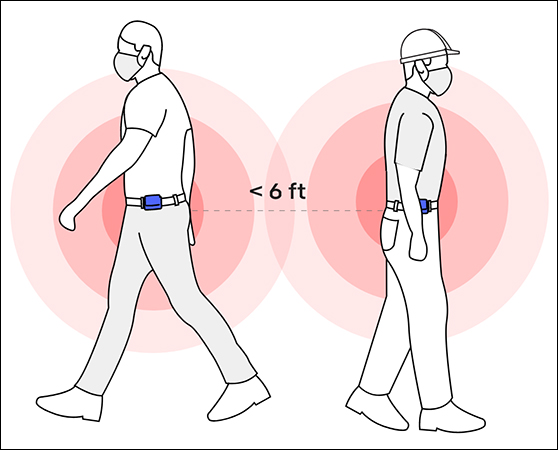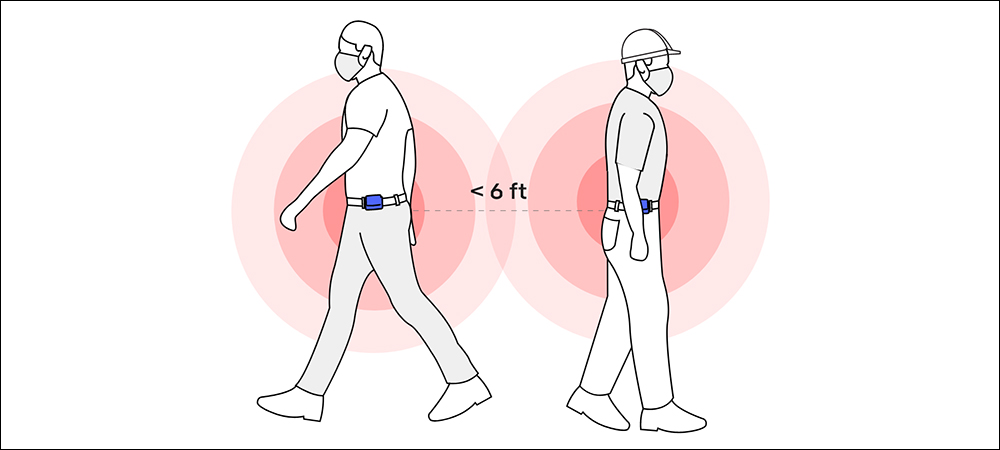Wearable technology company Kinetic has patented its social-distancing and contact-tracing system that serves as a new part of its Reflex solution, and it has released the patent to others seeking to build their own such solutions. The company’s wearable sensor device employs Bluetooth Low Energy (BLE) technology to detect the presence of other workers, and it vibrates to warn them while storing data about that contact. The patent, issued in September, includes technology for monitoring safety based on proximity and the logging of that data.
Kinetic is now opening the patent for free public domain use during the COVID-19 pandemic, through an Open COVID Pledge. The Pledge, introduced by a group of scientists, lawyers and entrepreneurs, is an agreement to make intellectual property (IP) available free of charge for use in ending the pandemic and minimizing the disease’s impact. Kinetic had already filed for the technology patent before the onset of the outbreak, in order to add a safety feature to its existing Reflex system for transmittable disease prevention, as well as for avoiding potential collisions if two workers come too close to each other.
 The company first released its worker-movement solution for use in the construction, manufacturing and logistics sectors, to help keep workers safe from injuries, mostly caused by repetitive movement stress, explains Haytham Elhawary, Kinetic’s cofounder and CEO. In fact, his interest in the technology centered around healthcare benefits and how workers can be better protected from the kinds of injuries that can take place on worksites.
The company first released its worker-movement solution for use in the construction, manufacturing and logistics sectors, to help keep workers safe from injuries, mostly caused by repetitive movement stress, explains Haytham Elhawary, Kinetic’s cofounder and CEO. In fact, his interest in the technology centered around healthcare benefits and how workers can be better protected from the kinds of injuries that can take place on worksites.
Since the technology was released, Elhawary reports, it has been used to ensure safety based on body physics. “Wearables were used to help workers achieve better body mechanics on the job,” he says. The unit measures activities that could lead to injuries, such as twisting, bending and over-extension. If it detects a problem such as a repetitive or potentially injurious movement, it vibrates as a warning for the individual to modify his or her movement. At the end of the day, the device is connected to a station for charging, at which point the data can be downloaded to Kinetic’s cloud-based software.
In addition to sensors, the Reflex device comes with an LED screen on the top that displays information about how well the wearer is meeting standards, or how often warnings have been issued. In that way, Elhawary explains, “It acts as a coach and generates friendly competition with colleagues.” The solution is now in use around the world, with approximately 25,000 workers wearing the device. “We see a 58 percent reduction in workplace injuries,” he states, at sites where the system is in use.
The device also comes with built-in BLE functionality. However, the BLE radio was not used until the new solution was developed. In March, Kinetic was approached by a customer with a warehouse at which employees were having trouble accomplishing proper social distancing. Because Kinetic’s device already has both sensors and BLE functionality, the company was able to simply update the software to enable a social-distancing feature, even while the patent for this kind of application was already pending. At the end of April, the new feature was commercially released to offer users the ability to be alerted if they are in close proximity with another such device, while a record of that duration was saved onboard the unit.
Here’s how the system works: A user is issued the device, the unique ID number of which is linked to that individual in the software. That data is provided only to authorized parties, such as an HR manager. Management can configure the device with requirements related to proximity (such as 6 or 10 feet) or the amount of exposure (for example, 15 minutes). As a worker goes about his or her day, the device transmits its BLE beacon data, which is captured by any neighboring devices within that pre-determined range. Once the devices have met the parameters for receiving alerts, each device vibrates and indicates a warning on its screen. In response, the wearers can simply back away from each other to provide social distancing.
For contract tracing, if a worker tests positive for COVID-19, he or she would report that status to the HR department or appropriate authority, and management can then identify, based on the history stored and downloaded from the device, any other sensors that may have come within range of the infected individual in the past several weeks. Those at risk can be contacted and quarantined if necessary. The contact-tracing feature helps reduce labor that might otherwise be used to identify which employees have been in contact with each other, Elhawary says.
The manual version of that process often requires interviewing employees, Elhawary notes, or watching CCTV footage to indicate who might be at risk of contracting the disease. “Now, literally, you just go to a table [in the software] and select ‘Show me all contacts’,” he says. Since the system was deployed, there have been instances when contact tracing has been required because an individual has tested positive for the coronavirus. In some of those cases, he says, the contact-tracing process was completed in two to three hours, whereas it might take 24 to 36 hours to accomplish the same task manually.
The system also provides analytics to help managers identify patterns that could introduce health risks into the workplace. For instance, management can view the data over a span of time and identify if excessive contacts have occured, such as in the lunch room, during breaks, or during shift changes at the beginning or end of the workers’ day. They can then adapt by staggering break times and lunch hours, providing more social distancing in lunchrooms and adjusting shift schedules.
Since the solution was released six months ago, Elhawary says, Kinetic has sold as many products as it did in its six-year history prior to that. Some companies already using Kinetic sensors simply upgraded to add the COVID-19 solution, while others have purchased the solution specifically for pandemic-safe workplaces. Kinetic expects that these same customers could benefit from the body mechanics safety detection feature for workers even after the pandemic has ended.
Companies now using the solution include JLG Industries, a construction equipment manufacturer that is using the system to help workers stay safe at its assembly plants in Wisconsin and Pennsylvania. Altogether, about 400 employees are wearing the devices to receive alerts if they come within close contact with another worker, or if they are excessively bending, twisting or reaching during a shift. Iron Mountain, a storage and information management company, is utilizing the system to protect its “mountaineers.” Like those at JLG Industries, the workers at Iron Mountain’s Chicago site use the devices for both social distancing and workplace injury prevention.
Warwick Ice Cream also uses the technology to help workers maintain safe distances at its Rhode Island manufacturing facility. The company deployed the Kinetic Reflex wearable in May of this year, after which it reported a 76 percent reduction in close employee contacts. The duration of contacts was reduced from seven minutes to 60 seconds. And Rhode Island cannabis manufacturer Mammoth reported a decrease in close contacts by 93 percent with the same technology.
While other wearable technology products also provide social-distancing alerts, Elhawary says this version is unique because it is offered as part of a worker-safety system that will provide benefits beyond disease prevention. “At the end of the pandemic, you have a solution you can still use,” he says, while many others might no longer be useful following the outbreak.
To date, Kinetic finds customers using its technology in several ways. “Some want to catch every immediate contact,” Elhawary says, while others only want to limit to the amount of time individuals remain in close contact. Modifications have already taken place based on technology data, he notes. Some companies were able to create space in lunch rooms, or have encouraged workers to eat lunch in their cars, when risk events were identified.
The system does not track the locations of individuals wearing the trackers. That lack of location data provides a privacy benefit that makes workers more likely to appreciate and participate in using the system, Elhawary says. “Tracking the location of people gets very sensitive,” he states. “Those using the technology have to feel comfortable.” Kinetic makes its own device hardware — and employed off the shelf chips for the BLE radios — manufactured by a third-party company based on that design.
By opening up the patent in September, Kinetic says it hopes to enable more solutions and devices to be used in the workplace worldwide, from a variety of technology companies. “It’s a pandemic,” Elhawary says. “It’s good that there are so many solutions. The more devices out there, the better.”


